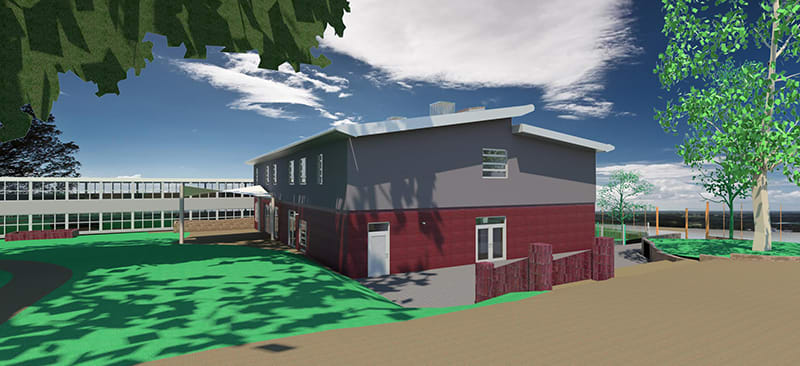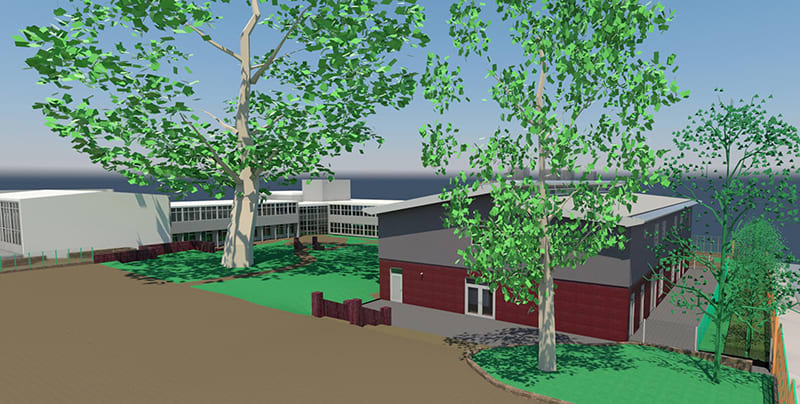- Client: Wandsworth Council
- Lead Contractor: Roan Building Solutions
- BIM Tools: Autodesk Revit, Navisworks, BIM 360
BIM processes helped optimise offsite manufacturing and reduce installation times on site when delivering the modular building specialist Roan Building Solutions’s first project compliant with Level 2 BIM, under RIBA guidelines.
The £1.9m project, due for completion in just two weeks, involves construction of a two-storey classroom complex with seven classrooms, open learning studios, cloakrooms, WCs, kitchen facilities and staffrooms. Designed to meet BREEAM “excellent” standards, the building will include mono-crystalline PV panels and wind catchers on the roof, plus sun pipes to increase natural light. The school is fully compliant with BIM Level 2, in line with the BIM Overlay to the RIBA Outline Plan of Work, published in 2012.
The great thing with a 3D model is you can zoom in and detail certain sections to ensure different components come together correctly, so you know that when you get into the factory all those components will fit together with the required fixings and loading paths etc– Jim Gowan, design manager, Roan Building Services
Jim Gowan, design manager at Roan Building Services, which acted as project architect and main contractor, told BIM+: “We made the decision in-house to make this our first BIM Level 2 compliant project to ensure we are able to provide the service to future customers. The client did not have any BIM requirements and did not see the benefits of BIM Level 2. However, they were happy for us to use it and liked the idea of using the 3D model to provide visualisations of spatial layouts.”
Roan coordinated the BIM implementation, authoring a 3D architectural model in Revit and sharing it with the project’s design partners, comprising structural steelwork specialist BW Industries, mechanical service engineer Kingstown Plumbing Services and electrical engineer HBC Electrical, via Autodesk’s BIM 360 collaborative data environment.
“Our Revit model formed the basis of their 3D models, which were sent back to us and federated in Autodesk Navisworks, ready for clash detection,” said Gowan, who confesses that certain teething problems had to be overcome along the way.
For example, the steel fabricator’s 3D model was produced in Tekla Structures, which had to be converted to IFC files for use in Revit. The team found it challenging to understand how the software interacts with IFCs and to get it to function correctly.

Roan set in place a BIM strategy to train up the design department for BIM Level 2, and educate the company as a whole on what it involves, their obligations and how the model could be useful in their work.
“We brought in subcontractors to give them an overview of BIM and the information we expected to receive from them,” said Gowan. “We tried to ensure that all suppliers already had a BIM capability and we worked with some of them to complete their design work and enhance their understanding of BIM.”
Wandsworth Council wanted minimum disruption on site (the existing school has remained operational during the work) so BIM’s 4D time planning function helped demonstrate to them the entire installation programme stage by stage, including when modules would be delivered, how many cranes and lorries would be on site etc.
The federated model was used to take off quantities, which were checked against measurements done traditionally in 2D to ensure the data was correct. In addition, the model was used to generate all the 2D information required by the factory for manufacturing the various modular elements.
This helped smooth the fabrication process, said Gowan: “The great thing with a 3D model is you can zoom in and detail certain sections to ensure different components come together correctly, so you know that when you get into the factory all those components will fit together with the required fixings and loading paths etc.”

According to Gowan, using BIM for clash detection helped save time and minimise disruption on site when the modules were being installed. “With many elements being built as separate units in the factory, then bolted together on site, it is often not until you get to site that clashes emerge, or you identify potential issues related to service runs and steelwork. BIM helped us put things right in the factory, which costs considerably less than when you’re on site.”
However, he admits that more errors might have been picked up, if the subcontractors, particularly for mechanical and electrical services, had been working on their BIM model much earlier on.
Roan produced an asset information model in BIM, and when specific geometric elements are clicked on, information on manufacturers and products is displayed. However, this feature will not be used by Wandsworth Council, which preferred to stick to its traditional method of using 2D information and O&M manuals.
“Even though we decided just to include product names and manufacturers, it was time consuming getting the asset information from suppliers, and, above all, trying to educate people that BIM requires a lot more information up front,” said Gowan.
Comments
Comments are closed.












Nick has done well here, good ideas are always good ideas forever.